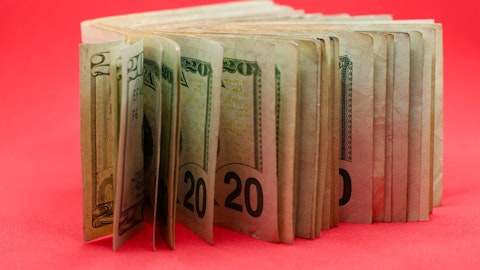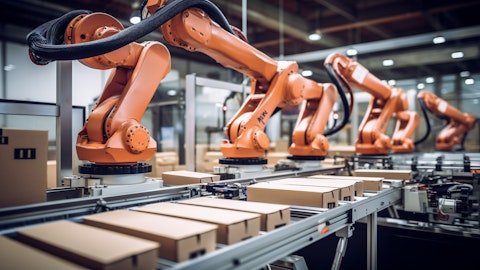And we will manage that really tightly and we feel we’ve got good leverage out of that today, and we are more efficient. And so you’ll see us continue to get leverage as we move forward in that. And really, that’s going to contribute to the long-term margin benefits that we’ve typically gained of 20 to 30 basis points a year in our business. So, you should see that continue to contribute to that on the longer term.
Unidentified Analyst: Okay, got it. And I appreciate all the color on that and on the volumes. But I guess you said volumes kind of came in lower than you were anticipating. So, what ultimately gives you comfort in the guidance for the year? Is it really that cost-out component and some of the other factors you talked to?
Ron Delia: Yes. Look, it’s a couple of things. Firstly, on volumes, we’re not anticipating any rebound in the consumer or any big improvements in the market. But we do expect that destocking will abate as we work our way through the half. I mean, certainly, a portion of the destocking that we saw in December was certainly year end optimization, that’s not going to repeat, right? We do believe we’re going to see continued destocking in healthcare and North American beverage. But for the other categories, we’re starting to see some evidence that the destocking is abating. So, that’s one thing. January also was much better. So, we had much better January relative to the first half from a volume perspective. And so we feel like — we feel pretty confident in underwriting the growth — the volume assumptions for the rest of the year.
And then in terms of the profit, as Michael alluded to, we’re going to continue to — we’ve got a number of known benefits, which I rattled through in the opening remarks, but it starts with better operating leverage because we’ve gotten a lot of costs out of the business and as volumes come back, we’re not going to add that cost back one for one, plus the buildup and the momentum on the structural cost side, which, again, will build through the second half with the benefits from plant closures and the like. So, several things that give us confidence in the improving trajectory of earnings through the second half, but none of them have to do with the real dramatic improvement at the consumer level.
Operator: Your next question comes from the line of Sam Seow from Citi. Please go ahead.
Sam Seow: Morning guys. Thanks for taking the question. But you talked about some of your volumes coming in modestly below expectations and just thinking about your balance sheet, I’m not saying it’s going to happen, but just trying to get a feel of what kind of fourth quarter volumes lead you outside of your range at the full year, assuming all other things equal?
Ron Delia: Sam, are you still there?
Sam Seow: Yes. Can you hear me?
Ron Delia: Yes. You broke up there for a second. You broke up right at an important part of your question, which is about fourth quarter volumes.
Sam Seow: Yes. Just try to get a feel of what kind of fourth quarter volumes there would leave you outside in your range at the full year, assuming all other things equal.
Michael Casamento: You mean the guidance range of $67 million to $71 million, is that right?
Sam Seow: No, no, the 3 times leverage?
Ron Delia: Okay. So, look, we’re confident in the cash flow trajectory of the business in the second half. So, we’re going to be delevering from here will be at approximately 3 times at the end of June. We’re pretty comfortable that, that’s the path we’re on here. In terms of volumes, the expectation for volumes that underwrites the EBIT growth in the second half or the EBITDA delivery in the second half is for mid-single-digit decline in the third quarter and a low single-digit decline in the fourth quarter. There’s a bit of — there’s a range around that. And the impact on EBITDA and then therefore on leverage is pretty broad. So, we don’t anticipate volumes being a major driver of us not getting to approximately 3 turns at the end of June.
Sam Seow: Okay. Thanks for that. And I guess just following on — I mean, looking forward, generally, you have lower cash flow in the first half due to seasonality. I think if you do finish at that 3 turns like your guidance, would you expect to be outside of your range again in first half 2025? Is that the new norm now going forward?
Michael Casamento: Look, I think just to answer your question on that front. If you take where we are right now at this particular point in time, it’s a pretty unique point in time because there’s two factors that are really impacting the leverage right now. We’re at 3.4 times, which is right where we expected to be at this time of the year in this situation. And it’s really driven by the divestment of the Russia business. So, we’re now fully lapping 12 months earnings out of the business from that. So, from here, we don’t lap that anymore. We head more into more normal earnings trajectory and growth. And that’s about 0.2 turn of leverage. And then the second point is really around elevated working capital levels. So, we have been carrying elevated working capital levels over the last 12 to 18 months.
We’ve started to work our way through that. And the teams have done a good job in the last 12 months of inventory where we’ve taken inventory out of the system about $500 million. And that certainly contributed to the cash flow improvement in the first half of this year where we’re $100 million ahead of prior year already. But we are still being impacted. We’re not getting the full benefit of that inventory reduction because our payables are much lower. So, in this environment, where we’ve seen demand softness and destocking, clearly purchases are well down and in turn, our payables are down. So, we — probably, we’ve still got another sort of $200 million to work through from a cash flow improvement on the back of working capital. And we’re really targeting a working capital to sales range of in between that 8% to 9% working capital to sales and right now, we’re at 9.8% on a trailing 12-month basis.
So, when you put those two items together, leverage at this time of the year would normally be in the more of the 3 times range. And typically, in the second half, the seasonality would take kind of a 0.25 turn of the leverage. So, we’ll get us back into that 2.5 to 3 times range. So, as we look forward, that’s where we would expect to be in a more normal base. But as I said, we’re in a little bit of a unique period of time and from here, we do expect improvement.
Operator: Your next question comes from the line of Adam Samuelson from Goldman Sachs. Please go ahead.
Adam Samuelson: Yes, thank you. Good morning everyone, or evening I should say.
Ron Delia: Hey Adam.
Adam Samuelson: Hey. So, I guess the first question just going on the volume side and just thinking about some of the end markets. And Ron, you gave some good color in the prepared remarks. One of the areas where Amcor has been investing more aggressively has been in the protein space. Can you talk about kind of incremental business wins that you’re actually achieving there relative to maybe some end markets that are still pretty challenged on the red meat side, certainly in North America? And how much you can kind of grow in spite of that and take market share in that opportunity?
Ron Delia: Well, yes, it’s a good question. And you’re right, the market is challenged. And so if we think about meat across the Flexibles businesses, it’s been a mixed story. We’ve had meat declining in North America through the half. There’s soft market, there’s destocking in the meat space as well. But we’ve seen that stabilize more recently. So, that would be one of those categories where we’re not calling an end to the destocking cycle, but we certainly see signs that it’s stabilizing a bit. Similarly, in Europe, we’ve seen a bit of a stabilization in meat volumes in the last couple of months. And in Latin America, we started to see some growth as well. So, I think meat is, as a general category globally, meat is one that feels like is coming out the other end of the packaging cycle, at least for us or at least there’s some green shoots that give us some reasons for optimism would be the first point.
Certainly, as we exited January as well, that would be the case. The second part of your question is a bigger picture question, and I think it’s going to be a little bit longer dated, which is around our aspirations to win share in this space. You’re aware that we made an equipment — a purchase of a machinery company less than 12 months ago, which should be a part of that total system solution that we’re going to market with. And we’re optimistic that we’ve got the right consumables, the right film structures and the right technical service staff to support the equipment offering. And we think over time, that’s going to be a combination and we’ll take share not just in North America but around the world. There’s not any evidence I can point to yet of that, Adam, because the near-term dynamics are well and truly overcompensating for any modest share pickup that we might be enjoying.
Adam Samuelson: Okay, I appreciate that color. And if I can ask just a quick follow-up. You do have a business and presence in Argentina, both for Flexibles and Rigid on the beverage side. I think you strip out all the inflation accounting for the deval, but you talked about the volume environment in Argentina and how you’re thinking about that over the next couple of quarters given what I would imagine it’s a pretty challenged consumer environment?




